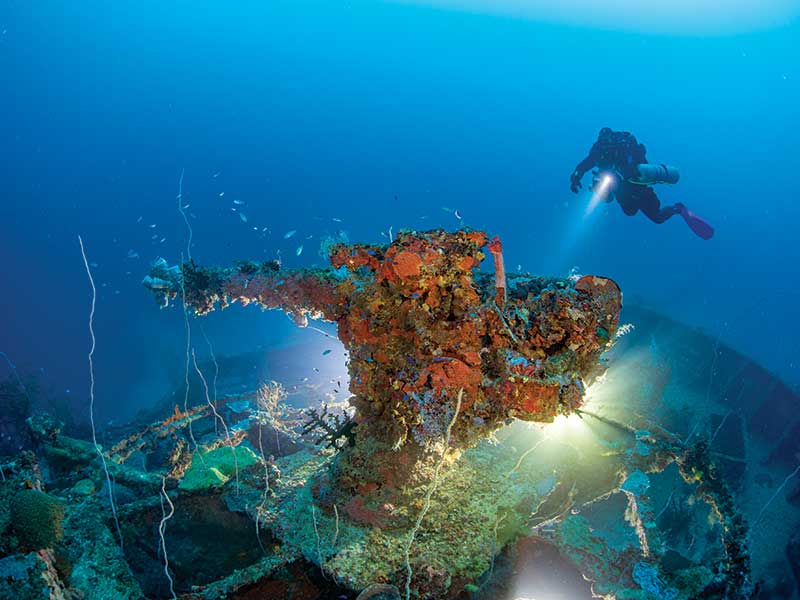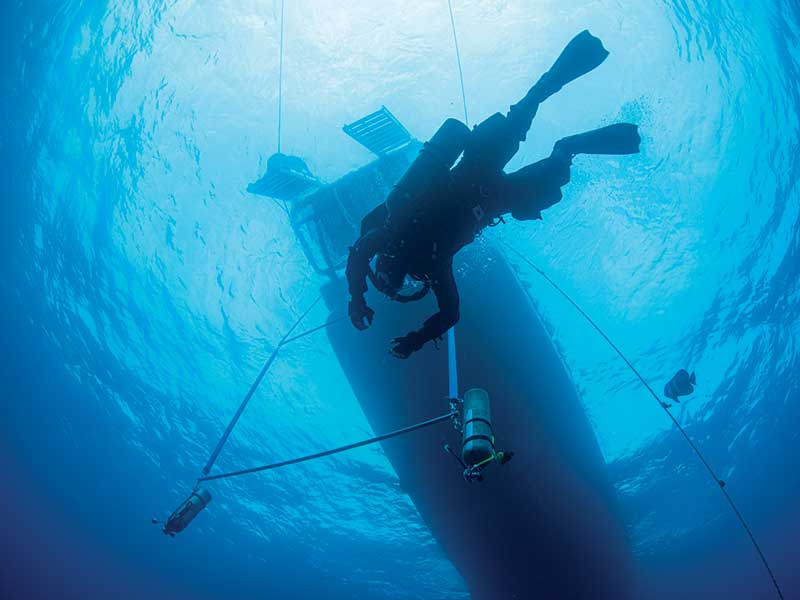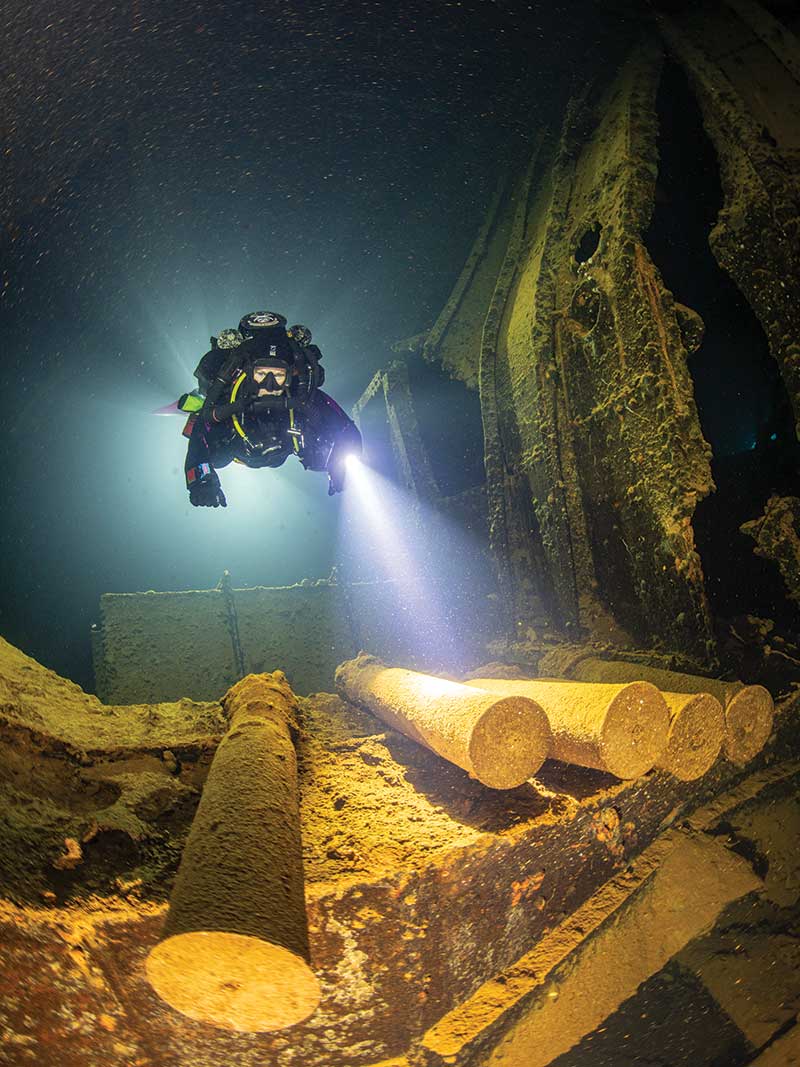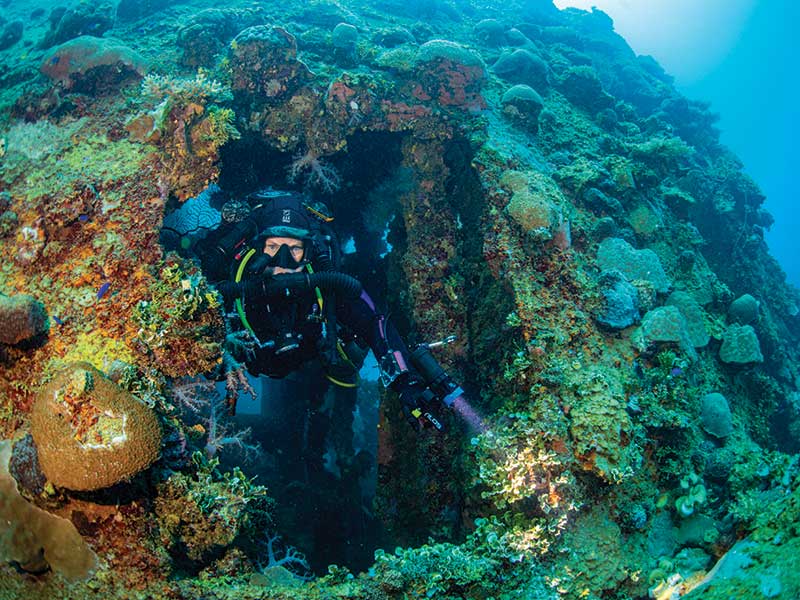Decompression Illness and Denial – Part 2
Demystifying Dive Computers
Words and Photography by Jill Heinerth

In my previous article I looked into incident reports that fell outside of the data gathered by organizations such as DAN. In this article, I’m going to dive into the physiology of decompression, gradient factors, and conservatism strategies. When you understand how your diving computer works to model decompression, you will better understand how to improve your personal safety.
Physiology
A review of fundamental underwater physics and physiology is useful. Almost every scuba diver has seen the same demonstration in class. Take two bottles of carbonated soda: open the first bottle quickly to watch the formation of large bubbles, then open the second bottle slowly and hear only a small burp or fizz. It is an excellent analogy for what happens in the human body when ascending from a dive.
Oxygen molecules are bound to blood by hemoglobin, and as we dive they also dissolve in our blood plasma. Nitrogen, which serves no purpose to the body, is dissolved into our tissues as we descend. As the partial pressure of gases in our lungs increases, more of this gas dissolves in solution. Descending increases the ambient pressure surrounding our bodies. If you descend to 100 feet (30m/4ATA) and stay there, eventually your tissues will saturate uniformly at this depth.
Our bodies contain different tissue types, such as blood, brain, ligaments, skin, cartilage, bone, fat, and other organs. These tissues are perfused with blood at different levels, absorbing and releasing dissolved gas at differing rates.
These different tissue types are grouped into ‘compartments’—a theoretical group of tissues that share similar gas saturation properties. In computations, each compartment uses a specific half-time. A ‘fast tissue compartment’ such as blood will on-gas quickly. A slow tissue with less blood perfusion—such as bone—loads and releases gas slower. Applying the concept of half-times means that the most significant degree of on-gassing occurs early, and the rate of absorption slows over time. For instance, a tissue with a 60-minute half-time fills up halfway after 60 minutes and then half of the remaining in another 60 minutes. In other words, that 60-minute tissue is 75% full after 120 minutes. The same concept applies in the opposite direction when the diver swims up. Off-gassing continues well after surfacing, much like that soda pop, that eventually goes flat over time if left exposed to ambient pressure.
If you stay down, all your tissues eventually fill with inert gas, becoming fully saturated. As soon as you start to ascend, the reduced ambient pressure triggers off-gassing due to supersaturation. As you swim up, fully saturated tissues are not capable of holding onto the gas. The reduction in pressure causes gas to diffuse from the tissues back to the lungs. If you keep breathing, you’ll be off-gassing, and if you ascend at a suitable rate, then that should give your body a chance to release the additional inert gas without incident. But this is a mathematical algorithm applied to a great diversity of divers. The math does not account for your age, shape, size, hydration, injuries, thermal factors, or activity level. It is predictive and useful but not a guarantee that you will never get bent. So what can you do to increase your safety margin when diving?
- Be physically and mentally prepared for diving
- Be well-rested
- Ascend within safe ascent rates
- Use a tested algorithm conservatively, accounting for increased risk factors
- Avoid tight equipment that constricts circulation
- Do a 3-5 minute safety stop at 15 feet (6m) on every dive
- Increase the conservatism level on your computer
- Stay properly hydrated
- Avoid post-dive exertion (such as lugging the tanks out of the water right after the dive)
- Carefully monitor exertion levels and thermal factors on dives so that they match during the working (on-gassing) and decompression (off-gassing) phases of your dive
- Use oxygen-rich mixes to aid in off-gassing (if qualified)
- Do some ‘surface deco’ time, relaxing before leaving the water if thermal factors allow you to do so

Basic decompression theory
The human body needs to re-acclimate slowly to surface pressure. It doesn’t happen magically at the moment we exit the water. It occurs through a careful, slow ascent and acclimatization based on mathematical predictions about how the body reacts to a reduction in pressure.
The point of saturation of most significant interest to researchers and mathematicians is a point called ‘critical supersaturation’. This is when a particular tissue compartment, or groupings such as the brain or bone, reaches the point where it is technically over-pressured or over-saturated. It has reached the point where no more gas can be dissolved into the tissues. It can no longer hold additional inert gas. This critical moment of reaching maximum pressure is known as the M-Value or Maximum Value. Given that we have many different types of tissues—tissue compartments—we have numerous M-Values to consider when building a decompression algorithm or mathematical model to predict how a human body will off-gas when ascending.
For recreational divers, most of the focus is on fast tissue compartments. The time and depth limits are made to keep the diver in a safe envelope for a direct ascent with a safety stop providing a margin of safety. Tech divers that stay down longer and go deeper, load both the fast and slower tissues, and that is where things get more complicated for the mathematician. Today, most rec and tech divers use computers to calculate multi-level profiles. That means that companies dedicated to providing instrumentation employ researchers and engineers to qualify, test, and continuously improve their algorithms. As diving practices change over time, their work reflects new trends and activities, including mixed gases, rebreathers, surface intervals, longer dive times, and new environmental factors.
One size does not fit all
Tech divers such as myself make long and deep dives into challenging environments. We also make short recreational dives and some excursions that straddle what is considered as both recreational and technical diving. As data collection improves, researchers can look at real profiles and continue to develop logical models reflective of the type of diving we do.
Decompression models use as many as 16 different theoretical tissue compartments. During the ascent, the computer’s algorithm considers both fast and slow tissues and their different maximum values, (M-values). Traditionally, the different elimination rates were accommodated with a series of stepped pauses in an ascent to allow a particular tissue group to drop below its M-value by a certain amount. A decompression stop is held until it is safe to move up to another theoretical limit. Stops are added to accommodate additional M-values until reaching the surface. Deeper stops tend to be shorter than shallower stops that allow time for slower tissues to release their inert gas loads. Of course, deeper stops may also incur penalties. Some tissues can absorb inert gas even while other compartments are releasing gas. Sound complicated? How about multiple dives in one day or repetitious ascents during training dives? Mixed gases and other factors also complicate models. What is even more perplexing is that the presence of bubbles or micro-bubbles does not always result in the bends. We know that micro-bubbles in the capillaries around the lung’s alveoli can obstruct the blood flow and delay off-gassing. Those same invaders can completely block blood flow to nerves or other tissues resulting in damage or cell death. But we still can’t quantify the effects of longterm diving or frequent sub-clinical hits over a career of diving. Do you go home exhausted after a day of diving? Is that the result of sub-symptomatic bubbles? Will that affect your body over time? We just don’t know.
Mixed diving profiles, varied fitness, and diverse environmental conditions, in a relatively young sport, means messy data. There is a lot to digest, and it is difficult to distill it into neat little packages. For that reason, mathematical algorithms have to be sufficiently conservative to accommodate a lot of different practices and people. The original Navy Air Diving Tables were designed to be used by fit, young male military divers as test subjects. Researchers even defined an ‘acceptable’ hit rate for the subjects using those tables. When I was a young diver, we used the Navy Tables and extrapolated their limits in ways for which they were never intended. Fortunately, today, we have much better options for improving safety margins in diving. Conservatism factors and gradient settings can help divers make choices that better fit their circumstances.

Adding conservatism
Personal settings are all the rage in fitness wearables and apps these days. Did you know that your diving computer offers you an opportunity to consider personal factors and select a level of conservatism that recognizes risk assessment? Computer manufacturers offer a basic framework for diving, but it is up to us to make choices about how we use our instruments. Only we can assess additional risk factors such as age, injuries, illness, diving practices, thermal considerations, activity level, environmental factors, and buoyancy control that can affect our safety. Although many divers never delve into their computer manual deeply enough to play with conservatism settings, it is vital to do so.
Many computers allow for adjustment of personal conservatism levels. A recreational diver who selects a more conservative level leaves the water sooner due to reduced no-decompression limits. A technical diver who selects a more conservative level stays in the water longer on decompression stops. Generally, these settings are represented with +1 or +2 for more conservative and -1 or -2 as less conservative. There is also a neutral default level provided. The more conservative levels of +1 or +2 can be used to account for less than ideal diving conditions, fitness, or other risk factors or to match another computer of a different brand.
Gradient factors
One mathematical model named Bühlmann, after the developer, can be used with a strategy for modifying conservatism called ‘gradient factors’. Not all Bühlmann algorithms are identical. Computer manufacturers may modify the math or use differing assortments of tissue compartments to control ascent. To make things more confusing, not many users (or even instructors) have been properly educated about how gradient factors work. In a nutshell, there are two numbers in a gradient factor. A forward slash separates the numbers. 30/70 or 20/80 are examples of gradient factors. These factors alter the maths in a way that changes the diver’s actual dive profile in two ways. The first number (G.F. low) is more controversial than the second (G.F. high). The first number helps to generate the depth of the first stop. The second number offers overall conservatism. Both numbers refer to M-Values, the mathematical expression of the supersaturation limit of a given tissue compartment. You can think of these numbers as percentages. The first number indicates how close to supersaturation you want to be in the controlling (most critical) tissue compartment before you generate a decompression stop. If you selected 100, then you would be at the theoretical supersaturation limit. Selecting a lower number results in a deeper first stop. Then the second number (G.F. high) offers up overall conservatism. If I choose 70 as my second number, then I surface at 70% of the overall M-value of the model. 100 would mean no conservatism, and lower numbers result in increased overall conservatism. For example, 100/100 would be a hazardous profile. But 10/100 might be as well! I’ll come back to that.
30/70 is offered as a default on most computers that feature gradient factors. 30% of the M-value of the controlling tissue generates the deepest stop and slowly morphs to surface the diver at 70% of the M-value overall. Setting the G.F. high to less than 100% nets longer, shallower stops to reduce supersaturation in the slower tissues at the end of the dive. The problem with gradient factors is that we still don’t completely understand deep stops.
Conflicting research and erroneous social media posts over the years have led to pervasive misinformation. Recent research indicates that arbitrary deep stops may result in increased neurological hits. Arbitrary deep stops are not necessarily good things and are not the same as linearly calculated ones based on an algorithm that takes into consideration all personal factors. According to Professor David Doolette, “Since about 2005, evidence has been accumulating from comparative decompression trials that show deep stops are not more efficient, and possibly less efficient, than shallow stops.” (Gradient Factors in a Post-Deep Stop World, May 2019). According to his article, Doolette selects 70/85 for his dives. Gradient factors can be supportive of more conservative diving or destroy commonly understood mathematical principals that were initially intended to increase safety. We have much to study.

Adaptable algorithms
Some algorithms, such as Suunto’s Fused RGBM model, build in real-time feedback that can shift a decompression model based on actual diving behaviour. Reduced no-stop times, longer deco stop times, or additional safety stops are generated for an individual user based on their practices such as multi-day diving, reverse profiles, or rapid ascents, which are known to produce a high microbubble count. But divers completing simple recreational dives, absent of additional risk factors, are not subjected to these modifications in ascent times. A recreational diver who shifts into a risker envelope from deeper longer or more frequent dives, transitions into a more technical algorithm that reflects actual diving circumstances. The computing is invisible to the diver, modifying all stops and intervals. The newest algorithms support continuous ascent strategies as opposed to stepped decompression stops. When the leading tissues start off-gassing, the diver can slowly ease upward until they reach a ceiling, continuing upward when the depth changes are allowed.
Some computers permit the diver to select one of several different algorithms. This feature can be handy if trying to match a backup computer of a different brand or to participate in a team with matched profiles. To this end, I would suggest considering why you would want to match someone else’s computer. We all got into the sport to be in the water. If a few minutes of additional water time is a problem for your diving buddy, then there may be a more significant issue to address. Furthermore, our diving profiles, gases, behaviours and risk factors rarely aligned perfectly with another diver. Regardless of the decompression strategy you choose, remind yourself that it should be a reflection of careful risk assessment. Only you can make a choice that protects you from possible decompression illness in the short term and potential damage that might be injurious over a lifetime of diving.
Perhaps in the future, we will have fully integrated dive computers that plug into our biometrics in real-time. If we knew that we were getting ahead of effective off-gassing while we were still in the water, we could modify our decompression hang or prepare to breathe oxygen right after the dive.
With clear retrospective vision, I realize that I have probably suffered more than one DCS hit in my life. Once I knew what it felt like, I admitted that other tired days or a sore shoulder might well have been attributed to DCS. Diving physician Dave Sawatsky remarks, “When you suffer from DCS, even if you are treated and all symptoms resolve, in many cases you most likely still have resulting tissue damage. That area will have an increased risk of being ‘bent’ again for several months, years, or even for life. There are lots of examples of people getting bent in the same location a second or even a third time. The fact that you have been bent suggests that you might be at more risk of developing DCS than someone who has never been bent.”
Armed with that knowledge and with the benefit of having now contributed to DAN decompression research, I have made a few minor changes to my diving practices. I spend a little extra time on my last stop, and I continue to move my body throughout deco. If I was active during the on-gassing phase of my dive, then I remain mobile during the deco. I also ensure that my thermal condition stays as balanced as possible. If I was warm on the dive, then I better not get cold on deco, or I will be risking a slower off-gassing phase. These changes are based on logic and a desire to never have to experience a mandatory chamber ride again! Overall, staying a bit longer underwater has given me the chance to see manta rays, a swarming school of squid, and the sun drop below the horizon. These are memorable experiences that I would not have missed for the world.
There is no mathematical algorithm I know of that will ever guarantee safety. It is also unfair to blame a device if you get bent. Use your diving computer armed with the knowledge of how it works so that you can make good choices about personal risk. Your diving computer will open a world of opportunities and adventures to you and will help inform you about how to partake in those as safely as possible.
To read more from Jill, visit Into The Planet
Leave a Comment







